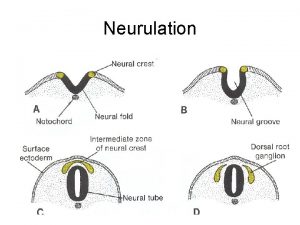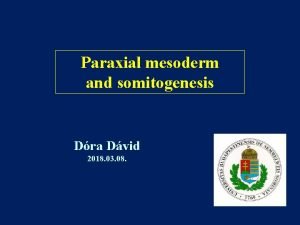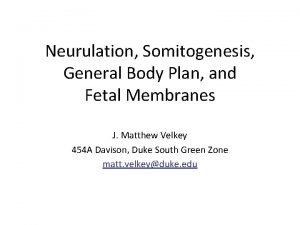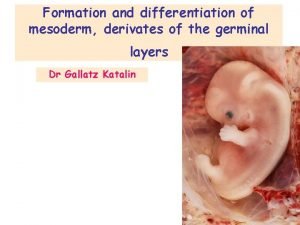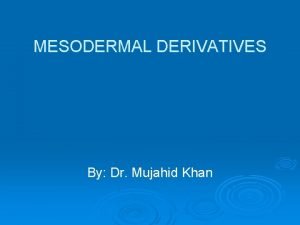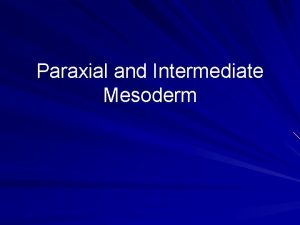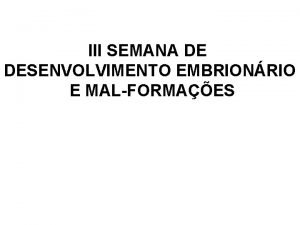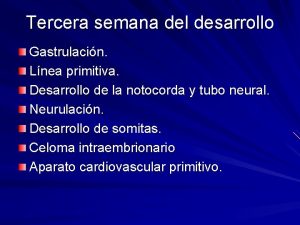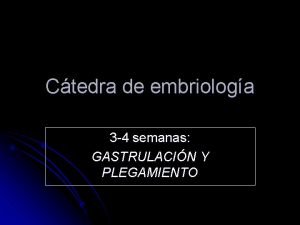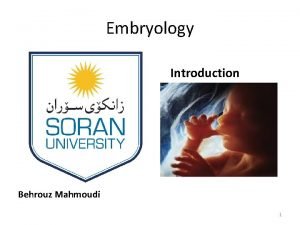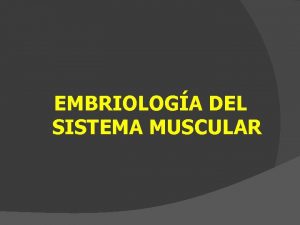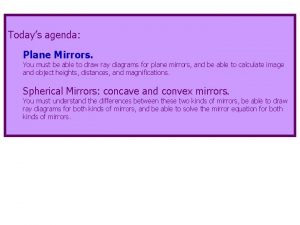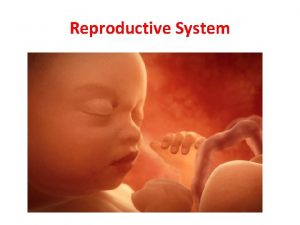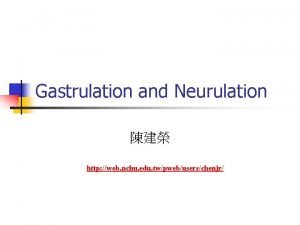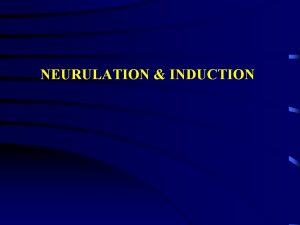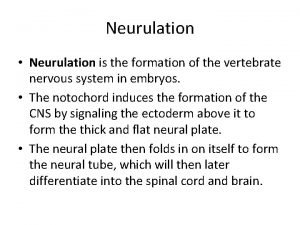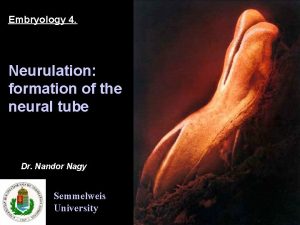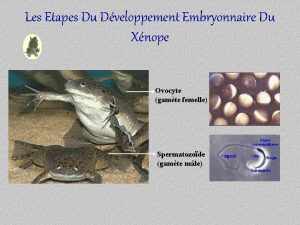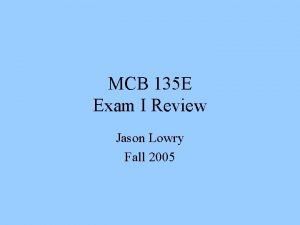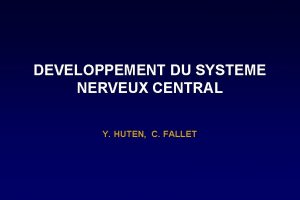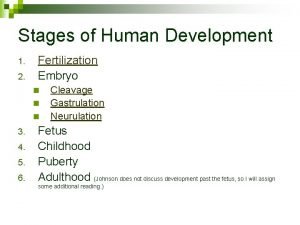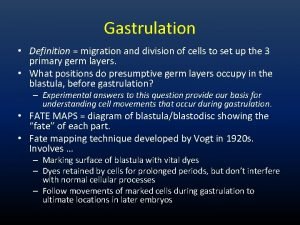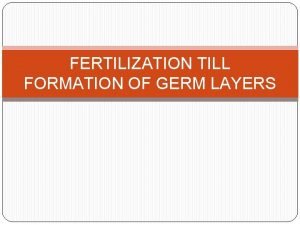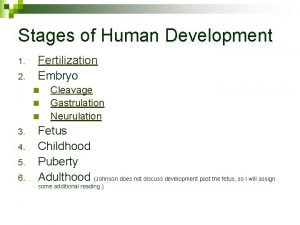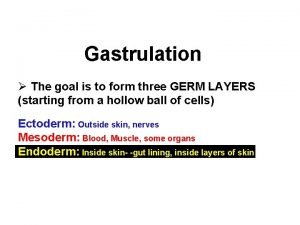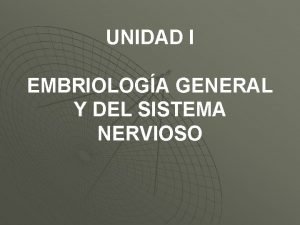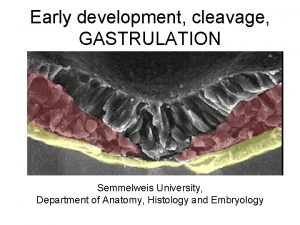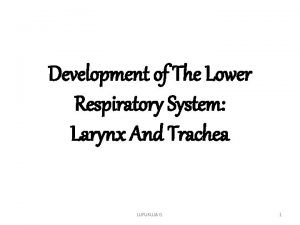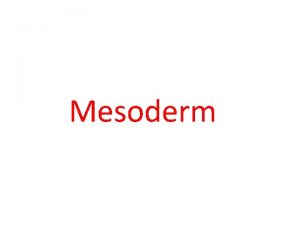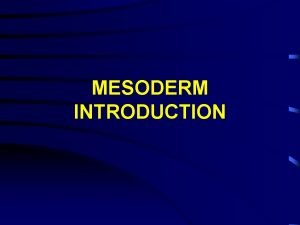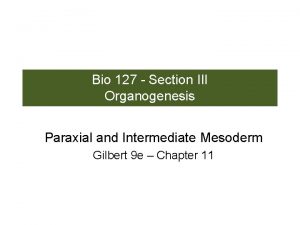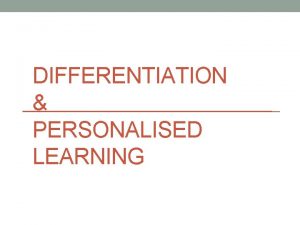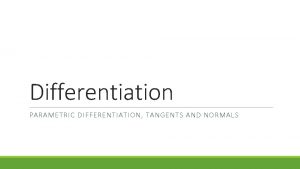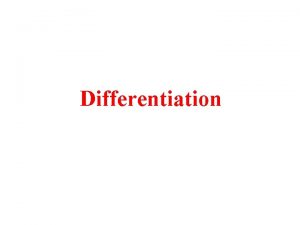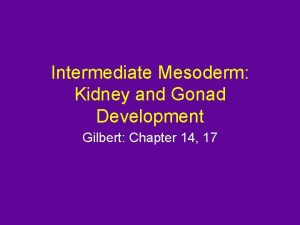Neurulation Differentiation of Mesodermal layer Paraxial mesoderm Intermediate












































- Slides: 44

Neurulation



Differentiation of Mesodermal layer • Paraxial mesoderm • Intermediate mesoderm • Lateral plate mesoderm


• Electron micrograph showing three parts of secondary mesoderm

Derivatives • • • Paraxial Mesoderm Intermediate Mesoderm Septum transversum Lateral plate Mesoderm Angiogenic layer

Derivatives I) Paraxial mesoderm • Sclerotome- vertebrae, portions of neurocranium, axial skeleton • Myotome- all voluntary muscles of head, . Trunk, and limbs • Dermatome- dermis of skin over dorsal regions

Development of sclerotome


Somitogenesis stages Compaction Epitheliasation Medial migration of sclerotome part of somites

Development of vertebra



Genes in somite development • • Sonic Hedgehog (shh) Myf 5 Pax 3 Myo D Wnt Nt-3 Bmp-4 Pax -1

Derivatives of somites • Tongue muscles by occipital Myotomes • 1 st occipital myotome disappears • Vertebra • Ribs • Joints, Ligaments, Cartilages

Abnormalaties • Hemivertebra • Mal development of occipito cervical junction Arnold Chiari Syndrome - Medulla and Tonsils project through Foramen Magnum • Inappropriate fusion of lower cervical vertebra causes –Klippel Feil Syndrome

Hemi vertebra

Hemi vertebra may also leads to scoliosis

Spina bifida

Arnold chiari malformation

Klippel-Feil syndrome • Low posterior hair line • Short neck • Limitation of head and neck • Scoliosis &kyphosis

Diastematomyelia

Diastematomyelia Clinical features: - Patients may have cutaneous abnormalities - a dimple, pigmented naevi or - patch of hair along their back at the level of attachment of cord

II) Intermediate mesoderm • Connective tissue of gonads, • Mesonephric and Metanephric nephrons, • Smooth muscle and connective tissue of reproductive organs • It is not before somitogenesis Development is closely related to progress and differentiation of somites Abnormalities can cause extropy of urinary bladder

III) Septum transversum Associated with development of Heart , liver , Diaphragm • Epicardium, • Fibrous pericardium, • Portions of diaphragm, • Falciform ligament, • Sinusoids of liver , • Mesentery of esophagus. Abnormalities can cause Diaphragmatic Hernias

IV) Lateral plate mesoderm Somatopleuric layer – • Appendicular skeleton, • Connective tissue of limbs and trunk (including cartilage, tendons and ligaments) • Mesenchyme of external genitalia, • Dermis of ventral body wall and limbs.

Splanchnopleuric layer – • Smooth muscle and connective tissue of respiratory tract , • Intestinal tract, • Associated glands, • Blood vessels

Development of limb budssomatopleuric mesoderm


• Cranio caudal axis of limb position is regulated by Homeo box gene (HOX) • Initiation of limb bud is by fibro blast growth factor -8 (FGF-8) • Out growth of limb by AER • Progressive zone • Limb patterning is regulated by ZPA along with AP axis of the limb

Effects of genes on the development of the limb buds • • AER --influences limb out growth AER– removal- Amelia Insert of AER – 2 axis of development Replacement with any other mesenchyme – no development of limbs • Replacement with lower limb mesenchyme leads to lower limb development & vice versa • Progressive zone is very specific it includes 8 stages of upper limb development

Hox genes specify each finger d-11 d-12 d-13 d-10 d-9

• • • Meromelia Amelia Phocomelia Micromelia Thalidomide Syndrome(1952 -1962 ) Polydactyly Ectrodactyly Cleft hand foot Congenital absence or deficiency of the radius

Thalidomide Syndrome(19521962 )


V) Development of splanchnopleuric mesoderm • Differentiation of mesenchyme around esophagus • Mesenchyme around trachea • Formation of lobes, their number, degree of maturity of lungs

Abnormalities – • Excessive laxity in effected air ways • Williams- Campbell Syndrome (bronchomalacia from 2 nd to 8 th generation of bronchi ) Clinical features – - Cough & tachypnoea, - Associated with tracheo- esophageal fistula - Bronchiactasis

VI) Angiogenic layer • • Endocardium of heart, Endothelium of blood vessels , Choroid plexus, Sinusoids of liver and spleen , Blood cells, Microglia, Macrophages

• Vascular system is first system to start development • Rapid vasculariziatrion and remodeling • Direction of blood flow is reversed a number of times

Theories associated with its origin • Blood islands in yolk sac endoderm • Vasculogenesis in the body of embryo is seen after the formation of extra embryonic blood vessels , hence it was believed that all blood vessels were derived from yolk sac • Recent evidences have shown that angioblastic cells are highly invasive and migratory in all directions its origin is also from endothelium of somites • Genes involved are Lmo 2 and GATA.

• Angioblast cells do not migrate into neural epithelium but form plexus of capillaries around brain Ultimate position of blood vessels is patterned by - mesenchymal population of head neural crest cells , - somatopleuric mesenchyme in limbs and - splanchnopleuric mesenchyme around viscera


References • Human embryology Inderbir singh • Langman’s embryology eigth edition • Essentials of Human Embryology A K Datta • Gray’s Anatomy 39 edition, Henry Grey
 Derivatives of paraxial mesoderm
Derivatives of paraxial mesoderm Paraxial mesoderm
Paraxial mesoderm Spina bifida
Spina bifida Mesoderm derivatives
Mesoderm derivatives Mesodermal derivatives
Mesodermal derivatives Paraxial region
Paraxial region Terceira semana do desenvolvimento embrionário
Terceira semana do desenvolvimento embrionário Mesodermo paraxial
Mesodermo paraxial Neuroporos
Neuroporos Hoja somatica
Hoja somatica Paraxial
Paraxial Epimero e hipomero
Epimero e hipomero Zona paraxial
Zona paraxial Formation of image of an extended object by a plane mirror
Formation of image of an extended object by a plane mirror Produces testosterone
Produces testosterone Primitive node
Primitive node Developmental biology
Developmental biology Neurulation definition biology
Neurulation definition biology Primary vs secondary neurulation
Primary vs secondary neurulation Somite
Somite Neurulation in human embryo
Neurulation in human embryo Neurulazione secondaria
Neurulazione secondaria Stade morula
Stade morula Neurulation
Neurulation Neurulation primaire
Neurulation primaire Neurulation
Neurulation Gastrulation and neurulation
Gastrulation and neurulation Gastrulation
Gastrulation Neurulation
Neurulation Fig 19
Fig 19 Layer 6 presentation layer
Layer 6 presentation layer Layer 2 e layer 3
Layer 2 e layer 3 Secure socket layer and transport layer security
Secure socket layer and transport layer security Layer-by-layer assembly
Layer-by-layer assembly How are glands classified
How are glands classified Secure socket layer and transport layer security
Secure socket layer and transport layer security Layer 2 vs layer 3 bitstream
Layer 2 vs layer 3 bitstream Secure socket layer and transport layer security
Secure socket layer and transport layer security Secure socket layer and transport layer security
Secure socket layer and transport layer security Will produce
Will produce Meningohidroencefalocele
Meningohidroencefalocele Notoshord
Notoshord Mesoderm
Mesoderm Splanchnic mesoderm
Splanchnic mesoderm Development of urethra
Development of urethra
